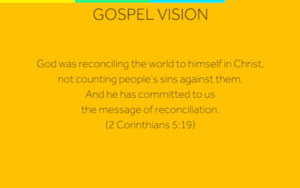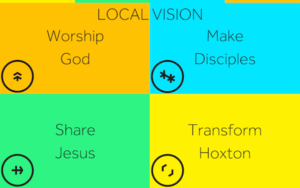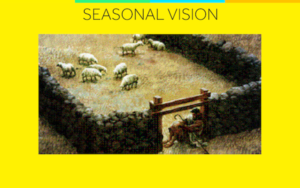Vision Sunday 2018: What's Your Gate?
Revd Graham Hunter preached a Vision Sunday sermon on Sunday 23rd September. The text of the sermon is below.
 William Temple, the former Archbishop of Canterbury once said this:
William Temple, the former Archbishop of Canterbury once said this:
‘The aim of prayer is the same as the aim of all life – it is union with Christ.’
The purpose of our lives is ever-increasing union with Christ. Growing, over time, to know him more truly; to love him more deeply; to follow him more obediently; and to reflect his image more faithfully.One of the great privilege of being a Vicar is that you get to see up close the development and growth of people in your congregation. I’m often amazed to see how people who begin perhaps on the margins, the edges, of our church family, over time move deeper into the centre of church life.Now, I don’t want to suggest that becoming more involved in the mechanics of church life is necessarily the same as becoming more deeply united with Christ – but I have often seen people’s faith grow, and their lives reflect Jesus’ love more beautifully, as they invest time and energy in the nurturing life of the church community.When we are rooted in the good soil of Jesus’ church, when we are refreshed and watered by the Holy Spirit, when we are fed and nourished by both Holy Scripture and Holy Communion, then we find that the tree of our lives will bear the fruit of the Spirit.Participating in the life of the church is, at best, a form of participating in the life of God and a place in which we discover and fulfil the Father’s will for our lives.One member of our church, Amanda, allowed me to share a little of her story. For Amanda, the story begins at Ivy St Family Centre – where she was taken aback by the friendship, care and consideration of some of the mums she met there a few years ago. When she left her bag there, the Ivy St team went to considerable efforts to get it back to her. She was befriended, and in due course, invited to come to a service here at St John’s.The first Sunday she came to this church, we had an extraordinary time of worship – and the Holy Spirit was doing amazing things. I remember my wife Sara was playing in the worship band – and kept saying to herself ‘Holy Spirit – don’t be weird!! Amanda’s here and I don’t want her to freak out!’ But speaking to Amanda afterwards she was struck by the power of the presence of God in that service – and by the fact that the Vicar was wearing jeans!!Amanda came on Alpha; she started helping on Sundays; she joined a Connect Group; she now leads the Sunday café team with Sandra and Debbie; she now leads bible studies sometimes in her Connect Group. Amanda’s faith has grown, and she has seen her life change. She has brought family members and friends to church – who in turn have come to faith in Christ. Her story is just one of many examples of how God is changing our neighbourhood one life at a time.
 Gospel Vision
Gospel Vision
We have a vision as a church to be a beacon of hope for Hoxton. But before I say more about what that means for us, I want set that vision within the context of a bigger story. I want to thing about what God might be saying to us in terms of gospel vision; big vision; local vision and seasonal vision.Gospel vision is about the eternal and unchanging purposes of God; big vision is about the wider context of our country and the world which God has called us to serve; local vision is about the more immediate context in which God has placed us; and seasonal vision is about what we sense God is calling us to focus on in the coming year.I have found the text in 2 Corinthians 5:19 really helpful for articulating the gospel vision – the big picture of what God’s eternal purposes are for humanity.The good news of Jesus Christ is that when we still far from God, enslaved to sin, he dies for us to make peace for us with God. He has performed the one perfect sacrifice that enables us to receive his grace. We can experience the reconciliation of humanity to its creator. At the heart of the gospel is the message that because of Jesus, we can know the peace, joy, hope and love that comes with being reconciled to God.
God was reconciling the world to himself in Christ, not counting people’s sins against them. And he has committed to us the message of reconciliation. (2 Corinthians 5:19)
 That’s the big gospel vision not just for our church, but for all Christians in all places and in all times – that we would share this message of reconciliation. That we would bear witness to the reconciliation that God has worked through Jesus.How do we bear witness though? What will be the visible sign of God’s reconciling work in bringing the world back to to himself through Jesus?It is the transformed lives of those who follow him – us! Transformation is at the heart of the gospel. God’s transformation of us from lost sheep to adopted children – from rebellious sinners to precious heirs.
That’s the big gospel vision not just for our church, but for all Christians in all places and in all times – that we would share this message of reconciliation. That we would bear witness to the reconciliation that God has worked through Jesus.How do we bear witness though? What will be the visible sign of God’s reconciling work in bringing the world back to to himself through Jesus?It is the transformed lives of those who follow him – us! Transformation is at the heart of the gospel. God’s transformation of us from lost sheep to adopted children – from rebellious sinners to precious heirs.
Therefore, if anyone is in Christ, the new creation has come: the old has gone, the new is here! (2 Corinthians 5:17)Behold! I make all things new! (Revelation 21:5)
This transformation is both objective and subjective – it’s a change in our status before God, but also a change in our experience of our lives. Transformation is both inward and outward – our attitudes changes, but so does our behaviour towards others – so our relationships and activities and priorities all change – and so this work of grace is made visible.The Anglican Collect for the 2ndSunday of Epiphany puts it brillianty:
Almighty God,in Christ you make all things new:transform the poverty of our nature by the riches of your grace,and in the renewal of our lives make known your heavenly glory;through Jesus Christ your Son our Lord, who is alive and reigns with you,in the unity of the Holy Spirit, one God, now and for ever. Amen
It’s the renewal of our lives that reveals the glory of God. The church is supposed to be a foretaste of a transformed society - it’s us, as a community of saved sinners, of the healed, the forgiven, the hopeful and the helpful.The influence we have in our neighbourhood is the means by which God is drawing people to himself in Christ. Christ is made known and revealed to people through his body, the church – animated, inspired and empowered by his Spirit. So the revitalisation of the local church is critical to the re-evangelisation of our nation and the transformation of society. That’s the gospel vision – a renewed and transformed community of people, reconciled to God in Christ, and through which the heavenly glory of God is made known; through whom God’s reconciling work is made known to the world.So how’s it going?
 Big Vision
Big Vision
The most recent British Social Attitudes survey has found that the proportion of our population who identify with the Church of England has dropped dramatically – from 31 to 14 per cent in just 15 years. Amongst 18-24 year olds, it’s down to 2%.In terms of the number who actively engage in church worship – frequently and regularly attending church for Christian worship, the proportion of our population is around 8% - but the CofE has just a 2% share!In terms of the projections, it’s anticipated that within the next 60 years, we’ll be down to under 10,000 worship Anglicans in this country. That probably means that about 75-80% of all of our churches up and down the length and breadth of our country will have to close.Now, we might well recognise that the C of E is just one part of the church of Jesus Christ. There are Pentecostal churches growing in number; Vineyard churches growing in number; all kinds of other free churches. And in one sense that’s true – we mustn’t get hung up on the C of E in and of itself – we’re followers of Jesus first, and Anglican ones second!But, the Church of England has a special vocation – a special calling from God – which is art of our DNA. And that call is to be a church for everyone in our communities – whether or not those people are Christian, Muslim, Atheist, Sikh, Jew, Jedi or anything else!That’s why C of E churches have such a deep commitment to social justice issues – like foodbanks or night shelters. That’s why the C of E has such a commitment to schools; it’s why we’re open and available to people of all different circumstances and at every stage of life.Close 75-80% of the churches, and that’s probably 75-80% of the toddler groups, pensioners’ teas; foodbanks; night shelters; youth groups and the rest gone. Who’s going to step in to fill the gap? The state? The humanist society? While there are all kinds of amazing people of all faiths and none who give time to various charities, none has such a commitment to their local neighbourhood as the Church of England.75-80% of our churches closed – with the loss of all those social goods and caring ministries? Over my dead body!I’ll gladly spend myself for the whole of my life on trying to preserve and promote this amazing mission that is entrusted by God to the Church of England. I don’t want to live in a country without this church.But to avoid this fate, the way we do church has to change. It’s change or die.We have to recalibrate our idea of a normal church. We need local parish churches, neighbourhood churches, that can operate with greater capacity, confidence and conviction.Too many of our churches carry a victim-mentality – wounded-ness as a badge of honour. ‘Well, we’d love to do more, but we just don’t have the resources; we’ll have to plod on faithfully. It’s not about bums on seats after all – it’s about faithfulness.’That’s the kind of language I sometimes hear from fellow clergy who are struggling on with dwindling congregations, decaying buildings and a desperate future. Of course, I’m sympathetic to some extent – it’s hard work. But we mustn’t justify failure or indulge a defeatist attitude on the basis of faithfulness. We mustn’t glory in shrinking congregations as though it was evidence that we’re not all about ‘bums on seats’.It is all about bums on seats!! Every bum on a seat is a part of a person – a person precious to God. A person whose ultimate human need is to experience what it means to reconciled to God in Christ. A person who needs to know the love, joy, peace and mercy of God in Christ. A person who needs to experience the healing, redeeming and transforming love of God expressed in our worshipping communities.In the Church of England, we need to change the narrative. We need to recalibrate what normal looks like. We need to inspire a generation of leaders – ordained, staff, volunteers – who will demonstrate resilience, tenacity, passion, dedication, creativity and energy for the task of seeing God’s church built up.No longer can we hold to a model of church which expects that there’ll be 50-70 people who all know each other like a social club, with a Vicar who will tear around trying to simply tend to everyone’s needs. Of course our leaders need to know how to pastor people, pray for people, lead people to Christ – but that doesn’t mean they’re the only ones who can do it! In a primary school, the Headteacher needs to know how to teach – but they don’t teach all the classes. Instead, they have to recruit, train, envision and empower a whole community of teachers and staff if they’re to successfully lead a flourishing school community.We have to remodel what it means to be a local church in the Church of England. One way I’ve found helpful for framing the question is not so much asking ‘how big can we grow’ but rather asking ‘how small can we be while still being able to accomplish the mission that God has set before us?’ And the answer is simply ‘not this small’.If the Church of England is to avoid walking off a cliff, if we’re going to recalibrate and reconfigure what ‘normal’ looks like, then we have to recover a confidence in the local, neighbourhood church with significant numbers of people – bums on seats – representing the whole diversity of the neighbourhood: ethnicity, age, culture and the rest.
 Local Vision
Local Vision
So let’s bring this back to the local – our church and our call from God. Our vision is to be a beacon of hope for Hoxton. Beacon fires in ancient days were used for communication, but beacons also indicated the presence of people. They were places where traveller could gather for safety, comfort, nourishment and rest. We want our church to be a beacon which draws weary travellers to our doors to find a place of warmth and welcome; a place of comfort and community; a place of forgiveness and friendship.How do we do this? We try to focus our efforts in four key areas: Worship God / Make Disciples / Share Jesus / Transform Hoxton. We have a bold vision to ‘repitch the tent’. Inspired by Isaiah 54:2, we’re seeking to expand the size of our tent – to make more room for more people. That’s why we continue to work on our #LoveHoxton development – so that we can refurbish this church building; construct a new annexe with better facilities for children, youth and community groups; provide more genuinely affordable housing for the local neighbourhood; and also to develop resource plans that will help support the church’s local mission in the years ahead.But we also have a bold aim to double the size of our worshipping community – to grow from around 250 adults and children to around 500 adults and children over the course of 5 years. Why are we trying to do this? Not to build our own little empire, but because every bum on a seat is connected to a person – a person precious to God. A person whose ultimate human need is to experience what it means to reconciled to God in Christ.And also so that there are more of us involved in serving our neighbourhood in love. Jesus says, ‘the harvest is plentiful, but the workers are few; ask the Lord of the harvest to send more workers into the harvest field.’ So that’s what we’re doing – inviting more people to be involved in this exciting mission. Paul Bayes, the Bishop of Liverpool, describes it this way: ‘A bigger church for a bigger impact’.And as you know, we have a special commitment to young people – children, youth, student and young adults. Not because they’re more important to God that older people, but because there are so many of them in our community and because so often the young are forgotten and marginalised in our society. Young people in church is a sign of hope for the future – a sign of God’s new fruit growing in each new generation. Young people are a sign of spring!But what does that mean for us here and now?
 Seasonal Vision
Seasonal Vision
In John 10, Jesus describes himself as a gate (v7), a gatekeeper (v3) and also a shepherd (v11). It’s a bit confusing – so what does he mean? He’s using an image familiar to his listeners – the image of a shepherd caring for sheep. Sheep, goats, and other animals were critical to the way of life of people in Jesus’ day. Wool, milk, meat were all provided through farming to provide for people’s lives.Shepherds lived with their flocks to protect their sheep from thieves, wolves or misadventure. They would lead them to good pasture where the sheep could graze and be nourished. They would go in search of lost sheep to bring them back to the flock. They would bring them back to a sheepfold at night to keep them safe from harm. The shepherd would sleep with the sheep – positioning their own body as a gate at the entrance of the sheepfold, to ensure that no sheep could leave during the night without disturbing the shepherd.But the shepherd who is also gatekeeper is not just there to keep the sheep in the sheepfold – he is there to lead them out (v3-5). Sheep are not just supposed to stay where they are – they are supposed to go out. ‘Therefore go and make disciples of all nations’ says Jesus. We don’t just stay within our walls – we also go out following the lead of our good shepherd.But the shepherd, who is also the gatekeeper, is also the gate itself!! In other words, Jesus is the way that we enter into the presence of God. ‘I am the way, the truth and the life’ says Jesus, ‘No one comes to the Father except through me.’And the good shepherd has sheep that are not of this sheepfold that he wants to gather in to become one flock (v16).What does this mean for us? Well, I think it means we need to get better at gatekeeping – we need to consider the different gates where God has made us gatekeepers. We need to consider which gates we should pass through to go further into the sheepfold, as well as which gates we should go out from so as to gather more lost sheep.Finally, we need to consider how we ourselves are gates through which other may pass to come into the presence of the good shepherd. Let me illustrate this. Do you remember those labyrinth maze puzzles? The kind with silver ball bearings that have to be delicately moved through different gates until they reach the centre? Well that for me has become an illustration of the work of our church in this coming season.As we participate in the life of our church, we pass through gates into deeper union with Christ. We move from the margins to the middle as we pass through each gate. And what are the gates? They could be internal gates – as we experience forgiveness, grace and reconciliation in areas of our lives. We could be transformed and set free from addictions or healed from wounds – and each of these may be a significant gate we pass through. But we also have visible ways of passing through gates.Let’s consider briefly the ‘gates’ that Amanda passed through: Ivy St – a transformational gate where she encountered Christians who practically embodied God’s love and care; a Sunday morning service – a worshipping gate in which she encountered the power and presence of God; the Alpha course – an evangelistic gate in which she heard and learned more fully of Jesus’ love for her and his reconciling work on the cross; and serving on the café team, joining a Connect group – discipleship gates in which she is formed more fully in the likeness of Christ.Each of us can pass through a gate as we journey deeper in our walk with God, but each of us also is a gate through which others may come to Jesus. You can invite friends to Alpha, Connect Groups, Prayer & Prosecco, Live at St John’s; you can embody God’s love and compassion by being involved with Foodbank, Ivy St, Hackney Citizens, children or youth outreach.The aim of all life is union with Christ. We are gatekeepers and gates for the good shepherd. How will we journey from the margins to the middle? How will we enable other to come with us? What’s your gate?
Let me illustrate this. Do you remember those labyrinth maze puzzles? The kind with silver ball bearings that have to be delicately moved through different gates until they reach the centre? Well that for me has become an illustration of the work of our church in this coming season.As we participate in the life of our church, we pass through gates into deeper union with Christ. We move from the margins to the middle as we pass through each gate. And what are the gates? They could be internal gates – as we experience forgiveness, grace and reconciliation in areas of our lives. We could be transformed and set free from addictions or healed from wounds – and each of these may be a significant gate we pass through. But we also have visible ways of passing through gates.Let’s consider briefly the ‘gates’ that Amanda passed through: Ivy St – a transformational gate where she encountered Christians who practically embodied God’s love and care; a Sunday morning service – a worshipping gate in which she encountered the power and presence of God; the Alpha course – an evangelistic gate in which she heard and learned more fully of Jesus’ love for her and his reconciling work on the cross; and serving on the café team, joining a Connect group – discipleship gates in which she is formed more fully in the likeness of Christ.Each of us can pass through a gate as we journey deeper in our walk with God, but each of us also is a gate through which others may come to Jesus. You can invite friends to Alpha, Connect Groups, Prayer & Prosecco, Live at St John’s; you can embody God’s love and compassion by being involved with Foodbank, Ivy St, Hackney Citizens, children or youth outreach.The aim of all life is union with Christ. We are gatekeepers and gates for the good shepherd. How will we journey from the margins to the middle? How will we enable other to come with us? What’s your gate?
